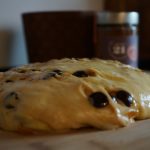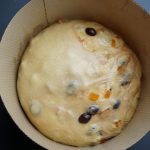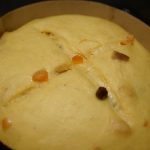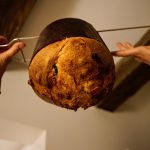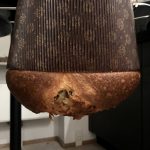Panettone is the Christmas´traditional cake of Italy. It is originally from Milan, and in Milan until 1900 there were many bakers and pastry chefs to produce panettone; today large industrial firms of panettone are located throughout Italy, while in Milan there are still many artisans who produce a panettone according to the traditional recipe. Very fragrant and very fluffy, traditional with candied fruits and raisins, or gourmet with chocolate, pistachio or hazelnuts, it is a must on all Italian tables on Christmas holidays. This year, since I live abroad, I thought I’d try to bake it at home. I started at making sourdough since October (look at the post on sourdough on my website) and finally the time has come to prepare panettone. I was speechless by how good and beautiful it became, I was almost excited. The work is not simple, we need the right equipment, a good sourdough and a lot of dedication. It takes at least two days to bake panettone : you have to dedicate yourself to him, in these days. I say at least two days because it depends on the time it takes for the leavening.. I was told that I had to wait for the right leavening of a panettone even 19 hours. Amazing!!
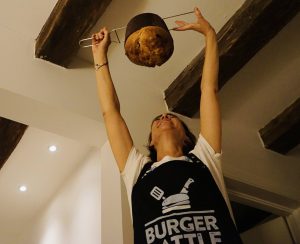
The recipe I propose to you is inspired by the master Morandin. I have tried to do it several times, testing the procedure; it is not easy to make but with good equipment (fundamental planetary and a strong sourdough), a lot of patience, a lot of love you will make fantastic panettoni!!! And even those who just don’t do well are very good :))
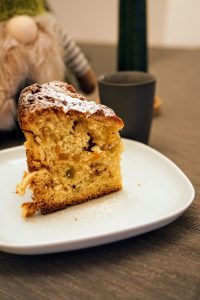
Equipment
- 1 kg or 500 gram panettone shapes
- Mixer
- Sourdough
- probe thermometer
- a spatula
Ingredients for a 1 kg panettone or two panettoni of 500 grams
First dough
- 105 gr. sourdough
- 95 g caster sugar
- 55 ml. Water
- 215 gr. flour 00 for panettone, W320-350 or manitoba
- 120 gr egg yolk (I recommend to buy pasteurized yolks in bottles)
- 25 ml. water (second dose)
- 135 gr. butter
Second dough
- First dough
- 55 gr. flour 00 for panettone, W320-350 or manitoba
- 20 gr. caster sugar
- 5 gr. salt
- 25 gr butter
- 25 gr. egg yolk
- 1 vanilla bean
- 100 g raisins
- 150 gr. candied orange
- 50 gr. candied cedar
Note
The raisin and candied can be replaced by chocolate, pistachios depending on the taste. The aroma of these panettone is the vanilla and suspensions that you want to add.
The sourdough, on the day of the start of the preparation, should be refreshed three times after bathing it. You can refresh it either with the flour with which you will make panettone or with a flour type 00.
For the sourdough bath: Cut the sourdough into slices one finger high and soak them in hot water (38 degrees) with a teaspoon of sugar dissolved for each liter of water. Wait for your yeast to rise afloat, no more than 10 minutes, squeeze it well (take only the yeast that is raised afloat), weigh the amount you want to refresh (at least 50 grams) and proceed as follows:
- First refreshments 50 gr sourdough – 22 ml water – 50 gr flour
- Second refreshments 50 gr. sourdough – 50 ml water – 100 ml flour
- Third refreshments 50 gr. sourdough – 50 ml water – 100 ml flour
Between a refresh and the other, 4 hours should pass. Your yeast MUST duplicate its volume within four hours; if this does not happen wait for the next refresh when the volume is duplicated. This is very important for the success of the panettone. A yeast yoo weak will not be able to raise the mass containing eggs and butter. If the volume does not double, do not continue. Let it rise to the heat covered with film. In the following a possible scheduling :
- 8.00 am first refresh
- 12.00 pm according to refresh
- 4.00 pm third refresh
- 0re 20.00 first panettone dough
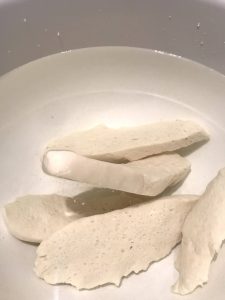
Dried fruits
The classic panettone is prepared with sultans (raisins), candied orange and candied cedar. These are optimal to give the panettone the right humidity that will make it the perfect light, sweet texture. They can still be replaced by the ones you like the most, pistachios, nuts, dates, dried apricots, dehydrated blueberries, coconut, etc., keeping the quantities unchanged . Except for chocolate. The chocolate after cooking, will tend to catch moisture from the panettone dough, so if we wanted to make a panettone with only chocolate, we will calculate 30% less than the weight of the planned sultans and candids. For a kilo panettone the planned candids and sultans are 300 gr, in the case of chocolate 300 – 30% = 210 g of chocolate. If you combine it with other flavors, such as candied orange, subtract only 10%, then 200 gr. orange and 100gr – 10% = 90 g of chocolate.
If your goal is to make a traditional panettone with raisins and candied wines, before starting the third sourdough refresh we take care of the sultans. After weighing it, put it in a container with hot water. Let’s soak it 30 minutes, then change the water, always hot, and soak the raisins for about 4 hours. Drain them well and transfer them over a clean towel where they will remain to dry until they are incorporated into the dough.
Preparation of the first dough
Well we’re ready!
In the bowl of the clean stand mixer fitted with a dough hook attachment, insert the sourdough, the first dose of water (55 ml), flour, sugar and eggs. Operate in low-speed . The speeds of my stand mixer range from zero to ten. I start kneading at speed 2 and when the dough begins to wrap around the hook increase to 4. To help the dough to wrap around the hook you can stop the mixer and with the help of a spatula collect the dough on the bottom and give it a couple of folds. The temperature of the dough must never exceed 26 degrees. If it increases, stop the mixer and put the dough in the fridge, for 30 minutes, then resume. It takes about 15/20 minutes until dough became very smooth and elastic. Only when the dough is smooth can you start inserting the second dose of water (25 ml) at speed 2. When the water has been completely absorbed, start adding the butter that should be very soft, in three times. Wait till the previous dose has been absorbed into the dough before proceeding with the next addition. Increase the speed to 4 and knead until dough is very smooth and elastic, about 15 minutes.
Turn the dough over a clean work top. Place the first dough in a graduated jug capable of containing three times the volume of the dough or in a large bowl. Cover the containers with film and place it to rise in the oven turned off with the light on trying to have a constant temperature of about 25/26°C. If we can have a stable leavening our dough will be ready in about 13/14 hours. If, after the time the dough is not ready, wait for the complete development (I told you to me and happened to wait 19 hours!). Be patient.

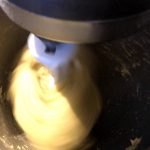
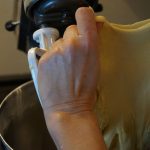
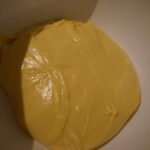

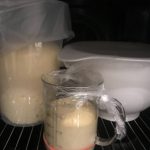
Preparation of the second dough
Did you wake up and find the dough with a three times volume? Great, let’s get to work! First we deflate the dough and put it to cool in a bowl in the refrigerator. If you want you can also put in the fridge the bowl of the mixer and the hook. We weigh all the ingredients, cut the candied and when everything is ready we begin to knead. We transfer to the bowl of the mixer the leavened dough with the flour. We knead at speed 2 and let the dough absorb the flour well. We continue to work, increasing the speed to 4: it is very important that the dough is well wrap around the hook before inserting the other ingredients. It will take about 15 minutes. When the dough is smooth, homogeneous, we stop the mixer and add all the other ingredients (the butter must be very soft). We re-enter the mixer and let it work for another 15 minutes at a speed of 2 then 4. The dough must be firm and smooth. At this point we are ready to insert the orange and cedar candied in cubes and the sultan (before inserting it into the compound better weigh it again because with the soaking it has deflated). Let’s insert them little by little at the minimum speed. When they are well blended with the mixture we stop the mixer and transfer the dough to a bowl that we will cover with film and let it rest in the heat for an hour.
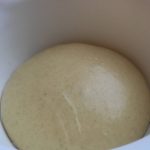
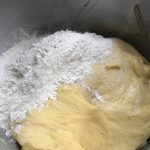

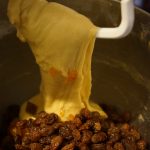
After one hour, we transfer the panettone dough to the work top and let it rest at the air for about 15 minutes . Depending on the size of the panettone shape you choose you will have to weigh the mass to be inserted into each one keeping in mind to put 10% more weight than the size of the shape to compensate for the loss of water that will have been during cooking. Then form a ball with ” la pirlatura” (see the video that show you haw to do it) and let it rest for about 15 minutes. Repeat the pirlatura and at the end of it put the panettone dough in the shape. Cover with film and let rise until the volume has reached 2 centimeters from the edge. It will take about 6/8 hours. Once the leavening is finished, remove the film and leave to the air for about 15 minutes during which heat the static oven to 165 degrees. With a sharp knife or razor blade, cut the surface in a cross and place a piece of butter in the center. Bake for 50/55 minutes in the lowest position of the oven as the panettone will grow again. At the end of cooking time to make sure that the panettone is perfectly cooked in the center must have a temperature of 94 degrees, to be measured with the thermometer. Take the panettone out of the oven and insert two metal skewers into the side of the panettone, halfway between the top and bottom of the panettone. Gently turn the panettone over so the cake is hanging upside down , suspended on the sticks. Leave to hang in this position for 10 hours. You can now package it in a food polypropylene bag. If you want to store it for a long time, even 60 days, spray inside the bag pure alcohol for 95° food, which will help the storage.

